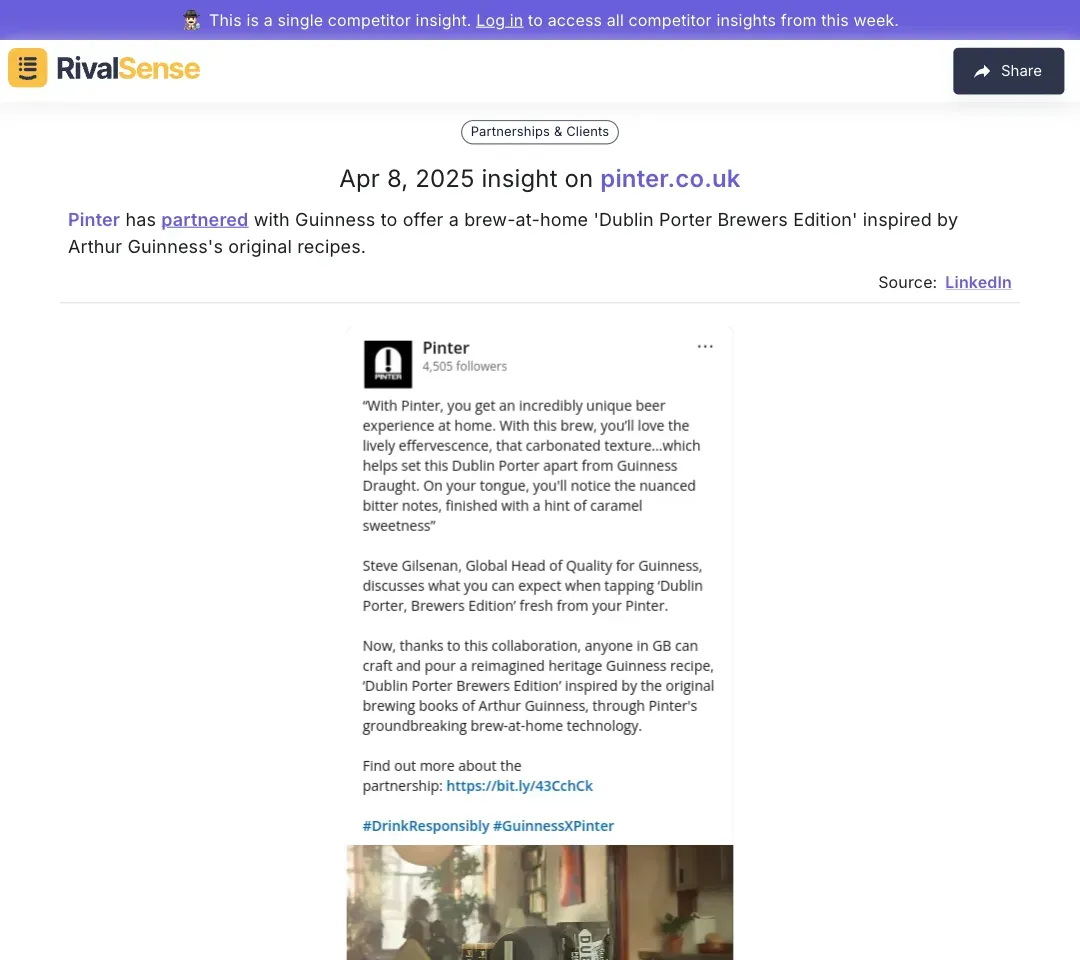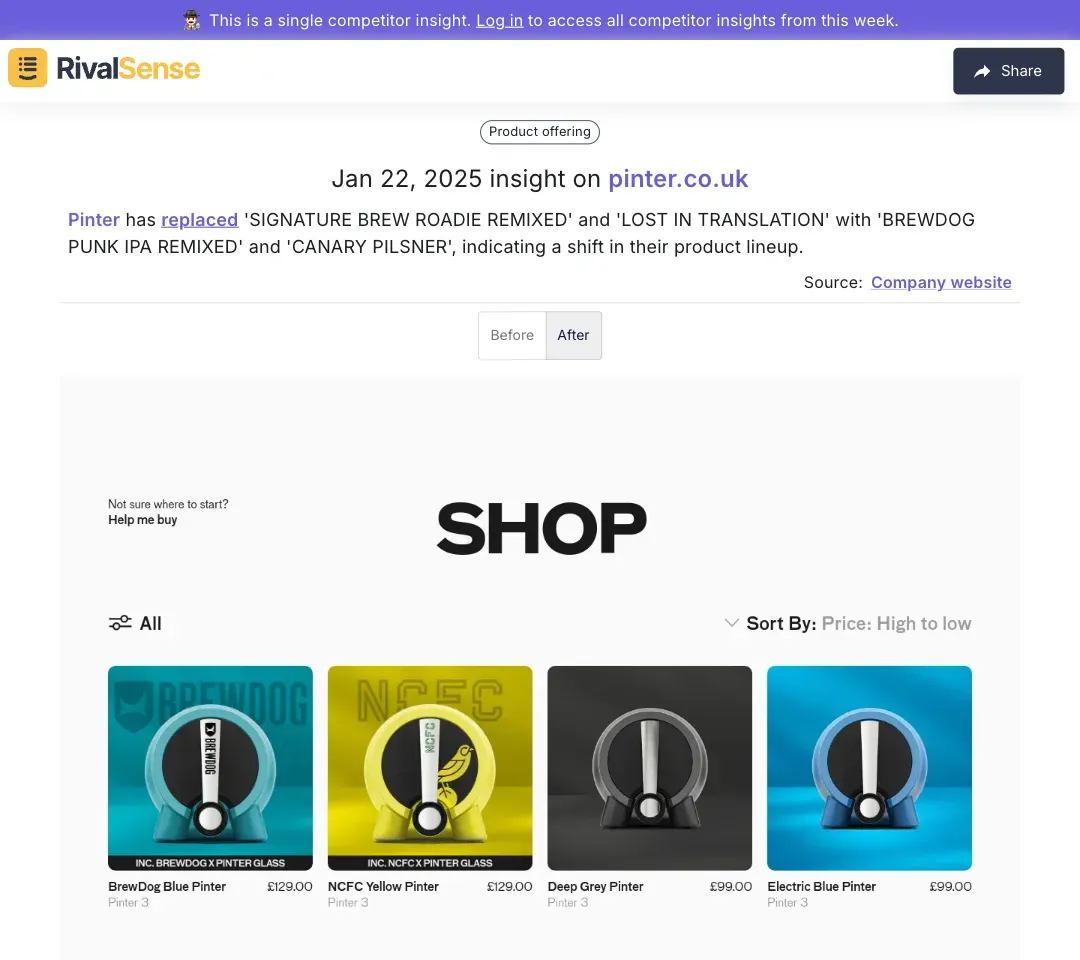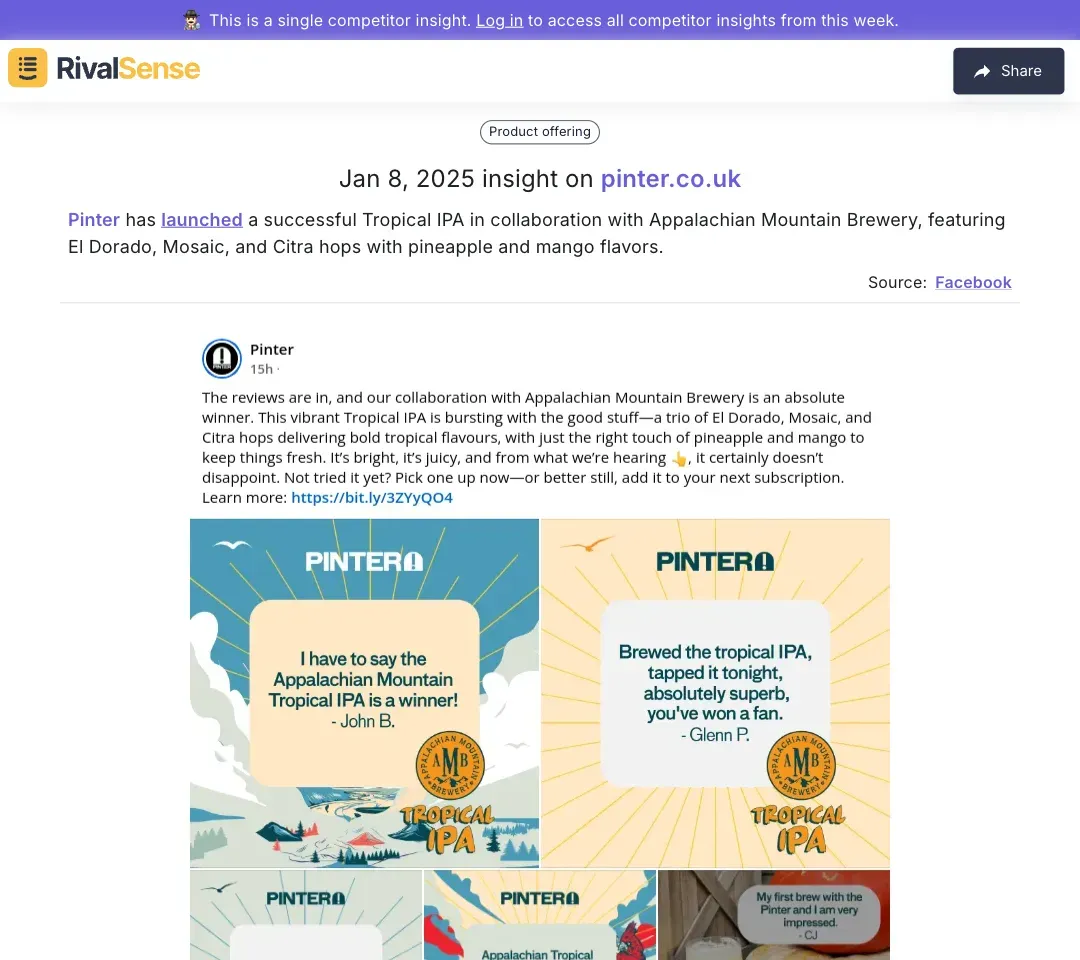The Ultimate Checklist for Crafting Competitor Profiles in Brewing Tech
In the rapidly evolving brewing tech industry, staying ahead requires more than innovation—it demands deep understanding of competitors' moves. Competitor profiling is a strategic tool that decodes rivals' strategies, strengths, and weaknesses, empowering you to anticipate market shifts and uncover untapped opportunities.
A comprehensive profile examines product offerings, market positioning, technological advancements, and customer engagement. This intelligence helps differentiate your solutions and identify collaboration potential. For instance, tracking partnerships like Pinter's collaboration with Guinness reveals how alliances expand market reach:

Why it matters: Such insights expose expansion tactics and co-branding opportunities.
Actionable Checklist for Profiling:
✅ Identify top 5 competitors
✅ Map product features & pricing tiers
✅ Track digital footprint (social engagement, web traffic)
✅ Set automated alerts for competitor news
✅ Quarterly profile updates
Analyzing Strategic Partnerships and Collaborations
Strategic alliances accelerate growth in brewing tech by combining resources and audiences. These partnerships often signal market expansion or credibility boosts, requiring careful analysis to decode their strategic intent. Monitoring collaborations reveals how competitors leverage complementary strengths to capture new segments.
Consider Pinter's partnership with Guinness to launch a heritage-inspired homebrew kit. This move taps into nostalgic branding while accessing Guinness' loyal customer base. Practical takeaways:
- Align with authentic brands sharing your ethos
- Analyze partner audiences for demographic synergy
- Measure campaign longevity—limited editions vs. ongoing collabs
Understanding Product Lineup Shifts
Product portfolio changes are critical indicators of market adaptation. When competitors retire or replace offerings, they reveal strategic pivots responding to consumer trends or operational constraints. Tracking these shifts helps predict industry directions and spot gaps in your own lineup.
Notice how Pinter replaced two brews with BrewDog and Canary Pilsner varieties, signaling a focus on trendy craft brands:

Why it matters: Real-time alerts on product changes prevent market surprise.
Monitoring Protocol:
🔍 Monthly website audits for new/discontinued items
📊 Compare features/pricing against your offerings
📈 Analyze review sentiment on replacements
⏱ Track product lifecycles for upgrade patterns
Exploring Flavor Innovations and Seasonal Offerings
Flavor experimentation defines competitive edges in brewing tech. Limited editions and seasonal launches create urgency while testing market receptiveness to novel profiles. These innovations often reflect deeper consumer behavior shifts worth reverse-engineering.
Pinter's Tropical IPA launch with Appalachian Mountain Brewery combined exotic hops and fruit notes, showcasing collaboration-driven R&D:

Why it matters: Tracking flavor trends identifies whitespace opportunities.
Innovation Framework:
🌱 Survey customers quarterly on flavor preferences
🍍 Partner with local suppliers for unique ingredients
🎯 Test small-batch releases before scaling
📅 Plan seasonal calendar around holidays/events
🔥 Create social teasers for limited editions
Leveraging Competitor Insights for Your Strategy
Competitor intelligence transforms raw data into strategic advantage when systematically operationalized. Analyzing rivals' successes and failures helps refine your product roadmap and marketing messaging while avoiding costly missteps.
Best Practices:
- Conduct SWOT analyses quarterly
- Benchmark pricing against feature sets
- Map competitors' content marketing funnels
- Automate tracking with tools like RivalSense
- Assign dedicated team for insight synthesis
Turn findings into action: If rivals under-serve a demographic, target it aggressively. If their product lacks certain features, highlight your superior capabilities.
Conclusion: Winning the Brewing Tech Innovation Race
Continuous competitor profiling isn't optional—it's foundational for market leadership. By implementing this checklist, you transform reactive observations into proactive strategy. The brewing tech landscape rewards agility; let competitor insights fuel your innovation engine.
Maintain Momentum:
🚀 Quarterly strategy sessions to update profiles
🚀 Cross-departmental sharing of competitor findings
🚀 Automated monitoring for real-time adjustments
Ready to streamline competitor tracking? Try RivalSense free to receive your first automated competitor report today. Uncover launches, partnerships, and strategic shifts while you focus on growth:
👉 Get Started Now
📚 Read more
👉 Boost Productivity with Strategic Competitor Insights on Partnerships
👉 Strategic Competitor Tracking: How to Stay Ahead in the B2B Landscape
👉 How to Analyze Competitor Support Strategies: A Founder's Guide to Winning Customer Loyalty
👉 🔍 Insurance Competitor Weakness Identification: Templates, Frameworks & Actionable Strategies
👉 How Marsh Redefined Real Estate Acquisitions – And What Your Business Can Learn
